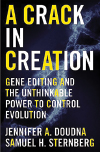
Aldous Huxley’s classic 1932 dystopian novel Brave New World pictures an eerie future where humans are genetically bred, altered to create worthy citizens. Welcome back to the future. First there was the astounding feat of sequencing the entire human genome; now, thanks to a revolutionary gene-editing tool called CRISPR (clustered regularly interspaced short palindromic repeats), we are able to make heritable changes in human embryos and, in effect, manipulate human evolution.
The developers of CRISPR, Jennifer A. Doudna, PhD, and Samuel H. Sternberg, PhD, have recently published a book, A Crack in Creation: Gene Editing and the Unthinkable Power to Control Evolution, about their scientific journey, which culminated in a tool that gives us the easiest, least expensive, and most effective way to manipulate DNA ever known. As long as a genetic code for a particular trait is known, scientists can use CRISPR to insert, edit, or delete the associated gene in any living plant’s or animal’s genome.
CRISPR may well open the door to cures of genetic diseases and cancers and may even help the world hunger problem; however, messing with DNA, even in the smallest way, could have huge unforeseeable consequences, to say nothing of the ethical issues involved when we have the ability to create “better” human beings. In the prologue of A Crack in Creation, the authors note that in 2015, Chinese scientists published results of an experiment in which they had injected CRISPR into discarded nonviable human embryos, but their study was a milestone in that it was the first ever attempt to precisely edit the DNA of a human germline. Dr. Doudna, who is the book’s primary voice, notes: “There is justifiable alarm over developments like these. Yet we can’t overlook the fantastic medical opportunities that gene editing gives us to assist people who suffer from debilitating genetic diseases.” Therein lies the scientific and ethical drama that threads though this excellent and important book.
The Tool and the Task
A CRACK IN CREATION is organized in two parts: Part I is “The Tool” and Part II is “The Task.” In “The Tool,” the authors treat readers to a concise and highly informative history of research that focuses on the discovery, in the early 2000s, that bacteria have an ingenious immune system that destroys invading pathogens by cutting their DNA into slices. CRISPR guides a killer enzyme to cut the bacteria’s DNA at a point where the 20-base sequence is found. In this section, readers will learn how the authors demonstrated that bacterial CRISPR could be programmed to cut any DNA from any organism.
BOOKMARK
Title: A Crack in Creation: Gene Editing and the Unthinkable Power to Control Evolution
Authors: Jennifer A. Doudna, PhD, and Samuel H. Sternberg, PhD
Publisher: Houghton Mifflin Harcourt
Publication Date: June 2017
Price: $28.00, hardcover, 307 pages
This is fascinating science writing that opens the door into the process behind laboratory discoveries. Not surprising, money and patents loom large in the history of CRISPR. Dr. Doudna recounts how soon after the breakout paper about CRISPR was published in Science in 2012: “Colleagues became rivals; papers were pored over for future patent battles.”
To the authors’ credit, the narrative is never dumbed down in an effort to reach a broader commercial base, and readers without a basic science background will find some of the content over their heads. To that end, the authors inserted diagrams here and there to explain bacterial and genomic mechanisms, but they seem like needless window dressing, one of the few complaints about this fine work.
At the close of “The Tool,” Dr. Doudna writes: “Weighing the dangers inherent in a technology like CRISPR against the responsibility to use its power for the benefit of humanity and our planet will be a test like no other. Yet it’s one that we must pass. Given the stakes, we simply have no other alternative.” Wise words, yet after reading the first half of this book, the reader comes away a bit jaded, having the sinking feeling that money and power seem to trump human ethics.
“Weighing the dangers inherent in a technology like CRISPR against the responsibility to use its power for the benefit of humanity and our planet will be a test like no other.”— Jennifer Doudna, PhD
Tweet this quote
Healing the Sick
MOST READERS will probably find “The Task” is the stronger of the two parts in that it deals with the nuts and bolts of this new era in the history of human life, an age where we exercise unprecedented control over the genetic composition of the species that coinhabit our planet. The ASCO Post readers will especially enjoy chapter 6 of this part, “To Heal the Sick.” Here we delve into how CRISPR can offer cures for our most dreaded diseases, such as cancer.
For instance, Dr. Doudna cites a Harvard Medical School study in which a team of researchers looked at the genetic causes of acute myeloid leukemia by programming CRISPR to edit different genes. Using live mice as surrogates, the team deduced the exact constellation of mutations necessary to promote leukemia. This is an example of the startling opportunities that CRISPR offers to cure cancers. It also amplifies the argument that despite very real ethical concerns about gene-editing abuse, this technology may have the potential to end so much human suffering and must move forward. As Dr. Doudna makes clear: “Just because we are not ready for scientific progress does not mean it won’t happen…. Every time we unlock one of nature’s secrets, it signals the end of one experiment and the beginning of many others.”
This book opens a Pandora’s box of unprecedented hope and dire warnings. It is highly recommended for readers of The ASCO Post. ■

